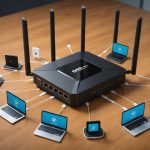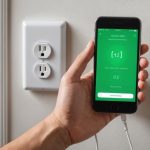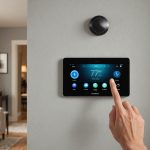Overview of Smart Plugs
Smart plugs are an integral part of Smart Home Devices, designed to offer convenience and enhance efficiency. Smart Plug Basics start with their core purpose: transforming ordinary electrical outlets into intelligent, remotely controllable assets. They allow users to control any device plugged into them via a smartphone app or voice commands, effectively managing electrical appliances from anywhere.
The potential for Energy Savings is significant. By scheduling devices to turn off when not in use, smart plugs help eliminate phantom power consumption—this is the energy that devices consume even when they are turned off. Additionally, most smart plugs measure real-time energy consumption, enabling users to monitor and optimize their energy use patterns effectively.
Topic to read : Unlocking the power of voice: your ultimate guide to smart home lighting control
Integration within a broader Smart Home ecosystem is seamless with smart plugs. They can sync with various smart home platforms, like Google Home, Amazon Alexa, or Apple HomeKit, to enhance household automation. For example, a user could set up a morning routine that gradually turns on lights, starts the coffee maker, and warms up the living room, all orchestrated through their smart plug network.
These features highlight the versatility and significant benefits of smart plugs, making them an essential component for tech-savvy homeowners looking to boost their home’s efficiency and connectivity.
In the same genre : Unlock your ultimate gaming adventure: key smartphone settings for optimal performance
Features of Smart Plugs
Smart plugs offer a variety of innovative features that enhance convenience and control over household electronics. One of the standout features is the ability to set timers and schedules, allowing users to automate their devices according to daily routines. This remote access feature enables control of appliances from virtually anywhere via a smartphone app, ensuring your home is always ready to welcome you. Additionally, smart plugs can offer significant savings by operating only when needed, easily adjusting for seasonal changes or personal preferences.
When it comes to connectivity, smart plugs primarily use two types: Wi-Fi and Bluetooth. Wi-Fi connectivity allows for seamless integration with a range of smart home ecosystems, providing long-range control and more robust automation capabilities. Conversely, Bluetooth options offer a more straightforward setup process, ideal for smaller spaces or single-room management without requiring an active internet connection.
Moreover, many smart plugs are equipped with energy monitoring capabilities, a crucial feature for those looking to reduce energy consumption and costs. These plugs can track and report energy usage, giving insights into which devices consume the most power. This feature not only helps in making informed decisions about energy use but also promotes a sustainable lifestyle by encouraging greener habits and efficient energy management.
Setting Up Smart Plugs
Installing a smart plug system elevates any home to modern times, turning ordinary electronics into smart devices. When embarking on this high-tech journey, the initial step is to ensure you select a smart plug that fits seamlessly into your home environment.
Choosing the Right Smart Plug
Understanding your home’s needs is essential in selecting the ideal smart plug. Consider factors such as the total number of devices you plan to control wirelessly and the electrical load these devices will carry. Additionally, ensure compatibility with your home’s Wi-Fi systems and any existing smart hub systems you wish to integrate, as not all plugs accommodate various network protocols.
Step-by-step Installation Process
Installing smart plugs is straightforward enough with the proper instructions. Start by unboxing the smart plug, ensuring all components are present. Connect the smart plug to an available outlet. Following manufacturer guidelines, download the relevant application from your smartphone’s app store. In-app instructions generally guide you through connecting the smart plug to your home network—details like Wi-Fi credentials may need input.
Connecting Smart Plugs to Your Smartphone
Integration with your smartphone is the real brilliance of these devices. It’s crucial for ensuring smooth operation. Confirm that your phone’s operating system aligns with the smart plug’s software requirements. Follow the application’s checklist to overcome potential connectivity hiccups, frequently related to network settings or interference. This connection opens up remote control and scheduling features, optimizing energy use and convenience.
Monitoring Energy Consumption
The importance of tracking energy usage cannot be overstated. It empowers users to make informed decisions about their consumption habits, potentially lowering bills and conserving resources. In today’s tech-driven world, several mobile apps provide innovative ways to monitor your energy consumption.
These apps offer real-time insights into your energy usage statistics. Downloading a recommended app like Sense or EnergyHub can transform your smartphone into a control panel for your energy habits. The app interface usually includes visuals, such as graphs and charts, that make it easy to understand your usage stats.
Understanding the provided energy usage data and metrics is critical. Metrics can include kilowatt-hours used, peak usage times, and cost estimates. This allows you to identify patterns, such as higher usage during specific periods, helping you target energy-draining habits.
Accessing energy monitoring through mobile apps offers convenience and precision. Users can instantly gain insights into their consumption, maximise energy efficiency, and engage with their energy usage stats comprehensively. These solutions cater to tech-savvy individuals seeking practical ways to embrace energy efficiency whilst simplifying the task with user-friendly interfaces.
Strategies for Maximizing Energy Savings
Implementing Energy-Saving Tips can greatly reduce your household’s energy consumption while fostering an eco-friendly lifestyle. Establishing an effective scheduling system forms a cornerstone of energy conservation, ensuring appliances operate during off-peak hours or when truly needed, thereby reducing unnecessary energy waste.
Smart Plug Optimization
One practical tip involves the use of smart plugs. These devices allow you to control appliances remotely, turning them off when not in use to save power. Optimize settings based on your daily schedule—or let artificial intelligence do the work for you. By programming smart plugs to deactivate during idle hours, they cut down on phantom loads.
Usage Strategies
To further capitalize on energy savings, consider adopting energy-saving usage strategies for various appliances. Invest time in familiarizing yourself with energy-saving modes and features that modern devices offer. For instance, enabling energy-saving modes on your television or game consoles can result in substantial long-term savings, minimizing energy consumption without sacrificing performance.
Moreover, it’s essential to optimise settings for different appliances, tailoring them to specific activity levels and times of day. From adjusting thermostat settings in the cooler months to fundamental choices like washing full laundry loads, simple changes can culminate in significant energy savings. By adopting these methods, you embrace a more sustainable approach while trimming utility costs.
User Testimonials and Case Studies
Exploring user experiences with smart plugs reveals fascinating insights into energy savings potential. Many users report significant reductions in their electricity bills, attributing these savings to smart plug utilisation.
Real-life Examples of Energy Savings
Take the case of John, who integrated smart plugs throughout his home. He experienced a noticeable 15% cut in energy consumption over six months. By scheduling devices to turn off during peak hours, John optimised his energy usage efficiently.
User Testimonials on Smart Plug Effectiveness
Recent smart plug reviews from various users echo similar sentiments. Sarah, a busy professional, finds that the automatic scheduling feature of her smart plug helps her manage multiple devices stress-free, while reducing unnecessary power usage.
Comparative Case Studies of Different Smart Plugs
Comparative studies shed light on the performance of various smart plugs. For instance:
- Brand A: Users appreciated the user-friendly app interface, although some noted occasional connectivity hiccups.
- Brand B: Favoured for its reliable scheduling capabilities, albeit at a higher price point.
- Brand C: Admired for affordability, but feedback indicated a lack of advanced features.
These success stories highlight smart plugs’ potential in fostering energy-efficient homes without compromising convenience, offering users a promising path to sustainable living.
Comparing Smart Plugs
It’s time to delve into the bustling world of smart plug comparisons, where variety meets technology. With countless options on the market, choosing the perfect smart plug can seem daunting. Fear not, as our product reviews highlight some of the best options available, making the decision clearer and simpler.
First on the list are popular brands like TP-Link, Belkin, and Amazon’s very own – each bringing unique strengths in the realm of smart home gadgets. TP-Link’s Kasa series is particularly noted for affordability without skimping on essential features. The Belkin Wemo, on the other hand, promises seamless integration with Apple HomeKit, appealing to users deeply embedded in the Apple ecosystem. Amazon Smart Plug promises easy setup with Alexa, making it a user-friendly choice for Echo owners.
Pricing varies significantly across these options. While most budget-friendly can be found around the $20 mark, others boasting advanced features can edge over $30. Our recommendations?
- If your budget is tight, consider the TP-Link Kasa.
- For Apple loyalists, the Belkin Wemo shines.
- And for Echo enthusiasts, Amazon’s offering could be your best bet.
User reviews further validate these choices, often praising the ease of use and reliability, helping to inform a well-rounded decision.
Conclusion and Next Steps
The realm of energy management and the efficiency of a smart home are rapidly evolving. Smart home efficiency not only contributes to sustainability but also delivers tangible benefits such as reduced energy bills. Let’s explore how embracing new technologies can provide such advantages.
Energy management is a crucial component of modern smart homes, and implementing smart plug solutions is an effective step towards achieving this. These devices allow homeowners to monitor and control energy consumption remotely, leading to opportunities for substantial energy savings. By integrating these solutions, the household gains greater visibility and control over their energy usage.
Future trends in energy management suggest a continued push towards more interconnected and intelligent systems. Investing in smart technology now could position homeowners advantageously as these systems become more integrated. The proliferation of devices like smart meters and automated lighting systems will likely become standard practice, improving smart home efficiency even further.
Recognizing this, consider the steps you can take today. Explore the various smart plug solutions on the market, each offering unique features, and find the right fit for your needs. By acting now, you can ensure that your home not only keeps pace with technology but also supports a more sustainable future. The future of energy management holds exciting possibilities, and staying informed and proactive will be key.











